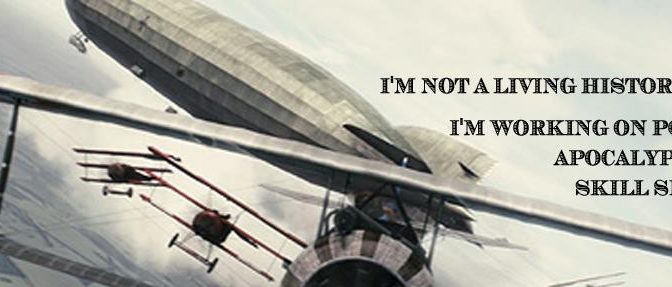 “I’m not a living historian; I’m working on my post apocalyptic skill sets” not just pretty words, they are a way of life. 🙂
“I’m not a living historian; I’m working on my post apocalyptic skill sets” not just pretty words, they are a way of life. 🙂
Something that stuck with me from very early in life was be prepared for likely as well as unlikely events. A big part of being prepared is being as self-sufficient and possible, having the skills to accomplish basic subsistence tasks from the raw material level up to the end user level for as many trades as possible.
In gardening this would be from saving or finding seeds, planting, harvesting, and ultimately preserving for storage or preparing for consumption. In woodworking it would start with the harvesting of timber, rough milling, drying, preparing board lumber, then finally building whatever you need. In textiles it might start with raising sheep, shearing, drying and washing, spinning, weaving or knitting fabric, and finally sewing.
I have spent many years learning a variety subsistence industries, endeavoring to learn them from raw materials to market in their basic forms or as close an approximation as possible. I also learned a broad range of survival skills for a number of environments. While learning these skills I came up with some strategies for living, beyond just survival, based on a combination of time-frame and technology. Most people with survival training are familiar with the “72 hr. Go Bag,” the 1 week or 2 week kit, and the “long term kit” which is usually for 30 days or so. However, generally speaking, anything longer than a few weeks is not considered in training.
My strategy goes further by assigning time-frames starting with survival for the first day or two moving into practical subsistence as quickly as is possible, subsistence begins with long term food, shelter, and security. Basically, with a Go Bag you are starting out somewhere just above caveman depending on what you take with you. Most kits won’t get you much further without becoming cumbersome and unwieldy. Getting from caveman to the 1300s can take a while even with a lot of early trade skills. Getting to the the pre-industrial era requires a huge skill set.
Once subsistence has been established it’s time to start working on advancing technology. As always, survival, subsistence, and beyond depend on terrain and resources so what direction technology takes is based on what’s available. This is where we start looking at available resources for power; in a natural-resource-only environment this would begin with wind and water power. How they are harnessed and what they are applied to is also dependant on the resources available.
To some this may sound a bit pessimistic, maybe even a bit crazy but others will likely be thinking “duh.” The real question is if you had to, could you? If you found yourself out in the middle of nowhere with no outside help available for the foreseeable future could you establish subsistence, then move onward and upward from there?
The reason I am bringing this up is a book I have been reading, Crystal Sets to Sideband by Frank W. Harris (KØIYE) Frank starts talking about building a crystal radio receiver, he mentions finding galina at an abandon mine and using it for the main crystal in several radio experiments. He also goes over the process of making diodes from raw materials. Although I have a limited knowledge of geology, mining, metallurgy, I do have a fair knowledge of processing refined metals, processing copper ore and drawing it into wire would take me a long time to get going. Starting from scrap metal would make it a lot easier and I most definitely have the skills for that.
Another thing Frank talks about in his book is a pyramid of skill levels starting with the collection and processing of raw materials at the the base and the purchasing of completed goods at the top. He references this to the ham radio operators of today, the average new operator these days buys their equipment putting them on the top of the pyramid with the old-timers and the DIY builders being somewhere around the middle.
 Looking at franks pyramid got me thinking of Maslow’s Hierarchy of Needs (right). I learned about Maslow back when I started working on my Flight Instructor certificate. This was in essence what got me thinking about extended survival, the “deserted island” scenario and later the “SHTF or EOTWAWKI” scenarios.
Looking at franks pyramid got me thinking of Maslow’s Hierarchy of Needs (right). I learned about Maslow back when I started working on my Flight Instructor certificate. This was in essence what got me thinking about extended survival, the “deserted island” scenario and later the “SHTF or EOTWAWKI” scenarios.
The best way to thrive in a situation is to move up Maslow’s pyramid and the best way to accomplish that is by moving down Frank’s beforehand, so to speak. The method for accomplishing this is using the strategy of increasing tech-level as frequently as possible, essentially establishing regular and sustained provisions for food, shelter, and security thereby setting the base of the pyramid allowing for higher level accomplishment. Getting from survival to subsistence as quickly as possible is an imperative, getting from subsistence to “living” expediently is desirable of course.
☮ ♥ ✈ & 73,
~FlyBoyJon / KK6GXG

